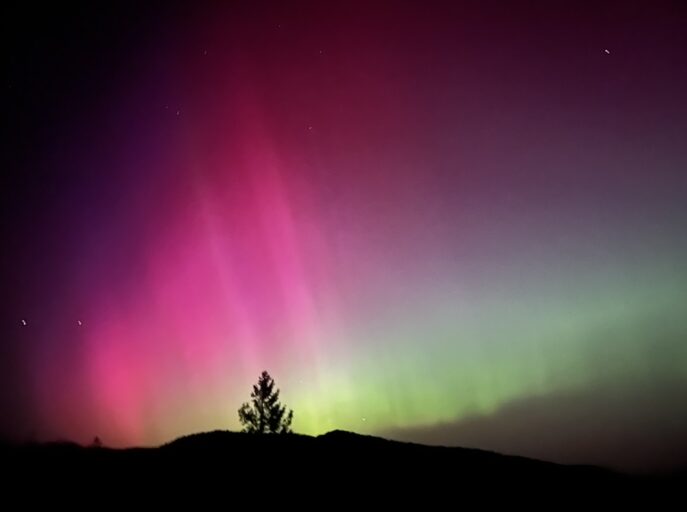
NORTHERN LIGHTS | Image captured in Boulder. (Photo/Courtesy of John Keller, Fiske Planetarium Director)
Newsroom El Comercio de Colorado
Haga click aquí para leer la versión en español
The northern lights may be visible again today, Saturday, May 11, in unusual places in the United States. It is not common for this phenomenon to occur so far south, after surprising those who observed it last night in various places in Colorado.
Social media users have shared images of skies illuminated with pinkish and greenish hues. The phenomenon captured in Boulder, Fort Collins, and Colorado Springs is caused by the interaction between solar wind and Earth’s magnetic field.
According to the World Meteorological Organization, it consists of a luminous phenomenon in the upper layers of the atmosphere with shapes like arcs, bands, or curtains. It occurs at an altitude between 90 and 150 kilometers.
It will happen again on Saturday, May 11
The U.S. Space Weather Prediction Center forecasts that it may be seen with intensity on Saturday nights, especially, and on Sunday in areas of the United States, Canada, and Russia.
The prediction from this center of the U.S. National Oceanic and Atmospheric Administration is that the phenomenon will reach its maximum intensity, of nine out of nine, in some hours of Saturday night in those areas.

VIEW FROM THE NORTH | The phenomenon was observed in Colorado Springs. (Photo/ X)
Alert for geomagnetic storm
Geomagnetic conditions in the atmosphere of the northern hemisphere are the most extreme recorded since October 2003, leading to the aurora being seen in places where it is very infrequent.
This scientific agency issued an alert on the G5 scale, the maximum on its scale, after several days of intense solar activity, as a geomagnetic storm of that level can cause problems in the electrical grid and navigation, radio, and satellite communication.
This year the Sun is experiencing a peak in activity in an eleven-year cycle, and this month of May, being close to the equinox, is when, due to the planet’s axis of rotation, there is greater penetration of solar wind into Earth’s magnetosphere.
Clearing up the mysteries
Despite the great anticipation they generate, auroras borealis still present many mysteries to science. To help solve them, on May 13, an expedition by four Spanish scientists begins by balloon.
They will record northern lights from the atmosphere, at an altitude of about 30 kilometers, departing from the frozen lake of Inari (Finland).
FRIDAY, MAYO 10TH| Aurora Borealis in Boulder. (Pictures/ John Keller, Fiske Planetarium Director)
You may also like:
COVID-19 Affected Individuals Live with its Effects
Celebrating the Board of Directors (2024-2025) of the COHCC.









otras noticias
FBI Investigates Boulder Tragedy as Terrorist and Antisemitic Attack
Hickenlooper: “How Many Times Are We Going to Punish Those Who Work?”
Only 25% of Students in Rural Schools Vaccinated Against Measles